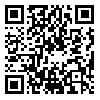Volume 20, Issue 4 (December 2022)
Iranian Rehabilitation Journal 2022, 20(4): 589-600 |
Back to browse issues page
Download citation:
BibTeX | RIS | EndNote | Medlars | ProCite | Reference Manager | RefWorks
Send citation to:



BibTeX | RIS | EndNote | Medlars | ProCite | Reference Manager | RefWorks
Send citation to:
Gholamizadeh K, Tapak L, Mohammadfam I, Soltanzadeh A. Investigating the Work-related Accidents in Iran: Analyzing and Comparing the Factors Associated With the Duration of Absence From Work. Iranian Rehabilitation Journal 2022; 20 (4) :589-600
URL: http://irj.uswr.ac.ir/article-1-1601-en.html
URL: http://irj.uswr.ac.ir/article-1-1601-en.html
1- Center of Excellence for Occupational Health and Research, Center of Health Sciences, Hamadan University of Medical Sciences, Hamadan, Iran.
2- Department of Biostatistics, School of Public Health, Modeling of Noncommunicable Diseases Research Center, Hamadan University of Medical Sciences, Hamadan, Iran.
3- Department of Ergonomics, Health in Emergency and Disaster Research Center, University of Social Welfare and Rehabilitation Sciences, Tehran, Iran.
4- Department of Occupational Health & Safety Engineering, Faculty of Health, Research Center for Environmental Pollutants, Qom University of Medical Sciences, Qom, Iran.
2- Department of Biostatistics, School of Public Health, Modeling of Noncommunicable Diseases Research Center, Hamadan University of Medical Sciences, Hamadan, Iran.
3- Department of Ergonomics, Health in Emergency and Disaster Research Center, University of Social Welfare and Rehabilitation Sciences, Tehran, Iran.
4- Department of Occupational Health & Safety Engineering, Faculty of Health, Research Center for Environmental Pollutants, Qom University of Medical Sciences, Qom, Iran.
Abstract: (3054 Views)
Objectives: Work-related accidents as one of the most prominent indicators of safety and health in the industry play an undeniable role in developing and improving the quality of industrial health management. Therefore, their accurate analysis on a large scale is essential. To provide controlling solutions, we aimed to investigate the causes of occupational accidents in Iran for 10 years (2007-2017).
Methods: At first, the reports of 10-year work-related accidents were taken from the Social Security Organization, then classified, and entered into SPSS software, version 18.0. Analyses were performed in two stages. Descriptive analyses were initially performed and then multivariate Cox regression was implemented to determine the significance of the effects of the identified factors. Accordingly, six parameters including the cause of the occurrence, gender, type of insurance, time of the accident, marital status, and type of accident were extracted as the effective factors. Next, the effect of each parameter was examined using multivariate Cox regression with a 95% confidence interval.
Results: The findings showed that falls and slips (18.3%) and physical strikes (14.6%) were the most common causes of accidents, and carelessness (61.9%) and equipment density (21.1%) had the strongest impact on accidents. Accidents had the highest incidence rate from 9 AM to noon (34.77%). The findings also showed that accident location (P<0.001), cause of the accident (P<0.001), type of insurance (P<0.001), and age (P<0.001) had significant effects on the duration of absence from work. Moreover, the findings demonstrated that the mental condition of workers and workplace design/layout had the strongest impacts on the rate of accidents.
Discussion: to control and reduce the risk of occupational accidents, appropriate working situations should be provided.
Methods: At first, the reports of 10-year work-related accidents were taken from the Social Security Organization, then classified, and entered into SPSS software, version 18.0. Analyses were performed in two stages. Descriptive analyses were initially performed and then multivariate Cox regression was implemented to determine the significance of the effects of the identified factors. Accordingly, six parameters including the cause of the occurrence, gender, type of insurance, time of the accident, marital status, and type of accident were extracted as the effective factors. Next, the effect of each parameter was examined using multivariate Cox regression with a 95% confidence interval.
Results: The findings showed that falls and slips (18.3%) and physical strikes (14.6%) were the most common causes of accidents, and carelessness (61.9%) and equipment density (21.1%) had the strongest impact on accidents. Accidents had the highest incidence rate from 9 AM to noon (34.77%). The findings also showed that accident location (P<0.001), cause of the accident (P<0.001), type of insurance (P<0.001), and age (P<0.001) had significant effects on the duration of absence from work. Moreover, the findings demonstrated that the mental condition of workers and workplace design/layout had the strongest impacts on the rate of accidents.
Discussion: to control and reduce the risk of occupational accidents, appropriate working situations should be provided.
Article type: Original Research Articles |
Subject:
Biostatistics
Received: 2022/02/12 | Accepted: 2022/03/19 | Published: 2022/12/7
Received: 2022/02/12 | Accepted: 2022/03/19 | Published: 2022/12/7
Send email to the article author








